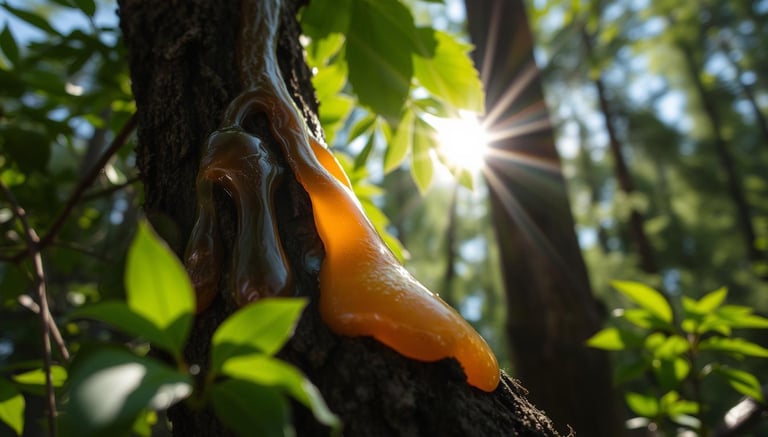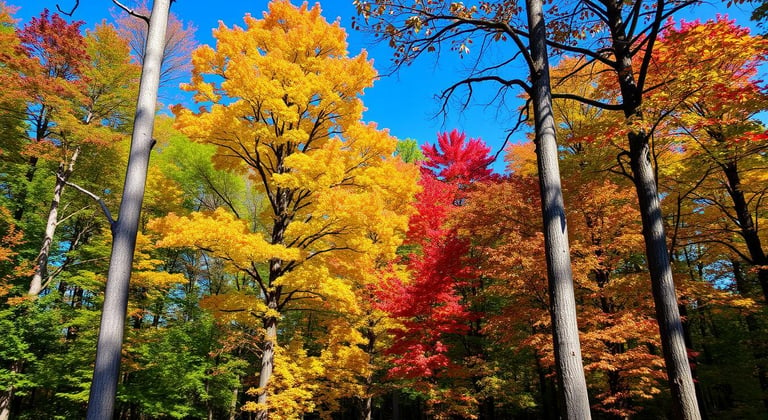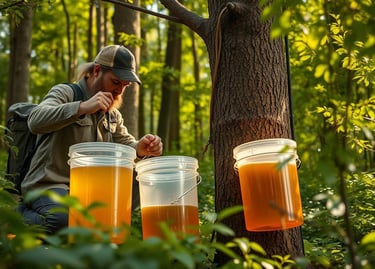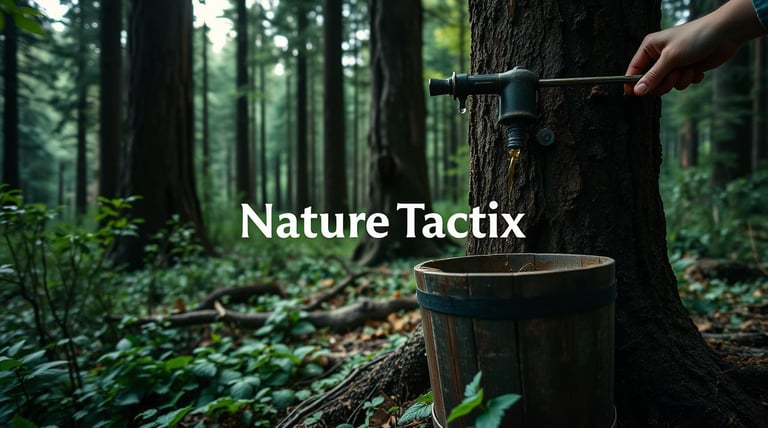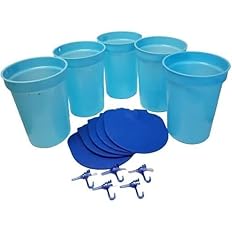
Harvesting and Using Tree Sap for Survival Guide
Discover essential techniques for harvesting and using tree sap for survival in the wilderness. Learn which trees to tap and how to utilize sap for food and medical needs.
SURVIVAL POSTS
Kathrine-Anne Hill
11/12/20249 min read
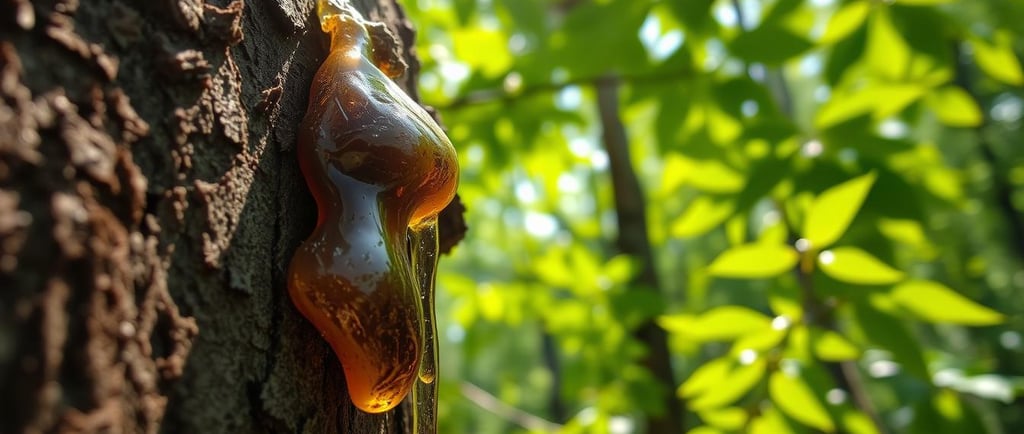

Affiliate Disclosure:
Please note that some of the links in this article are affiliate links. This means that if you click on these links and make a purchase, I may receive a small commission at no additional cost to you. This commission helps support the maintenance and growth of this website and allows me to continue providing valuable information and recommendations. Rest assured, I only recommend products and services that I have personally used or thoroughly researched. Your support is greatly appreciated! “As an Amazon Associate I earn from qualifying purchases.” For full disclosure see our Privacy Policy and Terms and Conditions here.
Harvesting and Using Tree Sap for Survival Guide
In the wild, knowing how to use tree sap is vital. It can be the difference between survival and just scraping by. Have you thought about using tree sap's natural sweetness to feed and sustain you in tough times? Learn how to tap into this resource and add it to your survival kit.
Key Takeaways
Tree sap can be used for food, medicine, and various survival applications.
Maple trees are the most well-known for their sap, but other tree species also produce valuable sap.
Proper techniques and timing are key for tapping and collecting tree sap.
Sap can be processed and stored for long-term use in emergencies.
Sap has many medicinal and first aid uses that can help in survival.
But how does tree sap help you survive in the wild? Let's explore its amazing uses and how it can be your secret survival tool.
Understanding the Basics of Tree Sap Collection
Exploring wilderness survival, tapping tree sap is key. Maple trees are tapped for their sap, a sweetener and a survival resource. Let's dive into the basics of collecting tree sap.
Best Seasonal Timing for Sap Collection
The maple tapping season is about six weeks long. It changes based on where you are. The best time is when nights are cold and days are warm. This cycle makes the sap flow, ready for us to collect.
Required Tools and Equipment
Drill: A power drill or hand drill is essential for creating the tapholes in the tree trunk.
Spile (or spout): This specialized tool is inserted into the taphole to allow the sap to flow out and into the collection container.
Collection container: A bucket, jug, or any suitable vessel is used to gather the flowing sap.
Identifying Suitable Trees for Tapping
Choose healthy trees with a trunk at least 25 cm (10 inches) wide. Sugar maple trees are top picks, but other maples work too. Drill holes about a meter up, angled slightly, and 3 cm deep.
Learning about tree sap collection boosts your wilderness survival skills. Next, we'll explore making maple syrup and other sap uses.
Maple Tree Varieties for Sap Harvesting
Harvesting maple syrup production involves tapping the edible sap of different maple tree types. The Sugar Maple is the top choice, but other trees can also be tapped for their sap.
The Sugar Maple's sap has about 2.0% sugar, making it perfect for syrup. The Red Maple is also a great choice, with high-quality sap. Bigleaf Maple, found on the Pacific coast, produces the most sap.
Other trees like Rocky Mountain Maple, Canyon Maple, Silver Maple, Norway Maple, Black Maple, and Bigleaf Maple are also good for tapping. They may not be as sweet as Sugar Maple, but they can give you tasty edible sap and natural sweeteners.
For example, Black Maple sap is as sweet as Sugar Maple's. Silver Maple sap has 1.7% sugar. Boxelders, though, only make half the syrup of Sugar Maples.
Exploring different maple tree varieties can open up new ways to enjoy maple syrup production and edible sap.
Birch and Walnut Sap: Alternative Sources
Maple syrup is well-known, but did you know birch and walnut trees have edible sap too? This sap can be used as natural sweeteners. Exploring these options can help you find more edible sap and natural sweeteners for survival.
Birch Tree Varieties and Their Properties
Birch trees, like Paper Birch and Black Birch, are great for sap. They have different flavors and sugar levels. For example, Paper Birch has the most sugar, about 1%.
Walnut Species for Sap Collection
Walnut trees, such as White Walnut and Black Walnut, also have sap for syrup. Walnut sap is less sweet than maple but is useful in survival. Black walnut trees grow tall and start bearing fruit at about 10 years.
Comparing Sugar Content and Yield
Maple sap is known for its high sugar, but birch and walnut sap are good alternatives. Research in Kansas in 2003-2004 found no commercial black walnut syrup production, but interest has grown after a book in 2013. The sugar content and yield of birch and walnut sap can vary. Yet, they are valuable natural sweeteners in survival situations.
"There has been an increased interest in tapping black walnut trees for sap after the publication of Michael Farrell's book in 2013."
Harvesting and Using Tree Sap for Survival
Exploring the outdoors is thrilling, but it needs careful planning and quick thinking. Tree sap is a hidden survival tool. It offers food and helps in cooking and foraging.
Tree sap is tasty on its own or can be turned into syrup. Birch sap tastes like a mix of water and wood. But, it's best to use it fast because it spoils quickly. You can make syrup or even birch sap wine to keep it longer.
Tree sap is more than just a drink. It can make food taste better, from stews to desserts. Using sap in cooking can make your survival meals special.
RNB Building Products Maple Syrup Tapping Kit comes with quality buckets and spiles designed to collect syrup.
Knowing how to use tree sap can be a game-changer outdoors. It's great for drinks, sweeteners, or cooking. Tree sap is a key survival tool for any outdoor adventure.
"Tapping into the natural resources of the forest can mean the difference between life and death in a survival situation. Tree sap is a hidden treasure that can provide sustenance, fuel, and even medicinal properties."
- Wayne Russell, Wilderness Survival Expert
Proper Tapping Techniques and Methods
Harvesting tree sap, like from maple trees, is key for wilderness lovers and self-reliant folks. Learning the right tapping techniques is vital for a good sap collection. Let's explore the main methods and tips for tapping trees.
Drilling Techniques
Choosing the right drilling method is important when tapping a tree. Look for a healthy, mature tree with a trunk diameter of 10-12 inches. Use a drill to make a hole 2-3 inches deep, angled slightly up to help sap flow.
If no sap comes out, try another spot on the tree. The sap might not be flowing well there. Once you find a good spot, stop drilling to avoid harming the tree.
Liberty Supply Maple Tree Tapping Drill Bit is the proper size for Tapping holes.
Spile Installation
A spile, a metal or wooden tube with a hole and spout, is perfect for tapping trees. Put the spile into the hole, making sure it fits well to stop sap leaks. If you don't have a spile, a short hose can work as a substitute.
Attach a bucket or demijohn to the spile or hose to catch the sap as it flows.
Collection Container Setup
Choosing the right container for sap is key. Look for strong, food-grade containers that can handle the weather and keep things clean. A healthy maple tree can give up to 5 liters of sap a day in peak season.
So, pick a container that's big enough. Don't forget to empty it often to keep collecting sap.
By learning these tapping techniques, you'll be ready to tap into nature's gifts. Whether you want to make maple syrup or just enjoy the outdoors, knowing how to tap trees is a great skill. It boosts your self-reliance and connects you closer to nature.
Processing and Storing Tree Sap
Harvesting edible sap from trees is a green way to get natural sweeteners. First, heat the sap well. This step gets rid of dust, bugs, and bark that might be in the sap.
After heating, strain the sap through a fine mesh. This makes sure the sap is clean and ready for cooking. Let it cool, and it will turn into a glass-like solid. Reheat it when you need it.
You can also make pitch sticks by mixing sap with charcoal and beeswax. These sticks are great for starting fires or as adhesives in emergencies. Well-processed and stored tree sap is a key resource for long-term sustainability.
The Vevor Maple Syrup Extractor Pan is a great product for large batch syrup production, and is compatible with wood, charcoal and propane for heating.
Learning how to process and store tree sap helps you use this natural sweetener for survival.
Medicinal and First Aid Applications of Tree Sap
Tree sap is a hidden gem in wilderness survival and natural remedies. From pine to balsam fir, it's full of uses. It's a sustainable and versatile option for first-aid and medicine.
Wound Treatment
Pine sap is great for wounds because it's antiseptic, anti-inflammatory, and antibacterial. It acts like a natural superglue for cuts and grazes. It helps wounds heal and prevents infection.
Balsam fir sap is also used by indigenous communities. It's good for pain and fighting off germs in wounds.
Natural Remedies
Tree sap is also used in traditional medicine. Chewing on soft pine sap or mixing it with honey and beeswax can soothe sore throats and coughs. Pine needle tea, rich in vitamin C, was used to fight scurvy.
The sap can also help with skin issues. Balsam fir sap is good for eczema and rashes.
Traditional Medicine Uses
Over 100 pine species are used in medicine by indigenous communities. The sap and resin are valued for their healing properties. They're used for pain, fighting germs, and helping with breathing.
Using tree sap can teach us a lot about survival, natural remedies, and sustainability. It's great for treating wounds, skin issues, and breathing problems. The wisdom of nature is in these plant resources.
Survival Applications Beyond Food
Tree sap is more than just food. It's a natural resource with many uses in survival situations. Its sticky, resinous nature makes it useful for more than just eating.
Tree sap is great for waterproofing. It can seal cracks in canoes and boots, keeping them dry. It also helps fix tents and tarps, keeping you dry.
Pine sap is key for starting fires. It can make torches and ignite tinder, even when it's wet. Its ability to help with fires shows its survival value.
Tree sap also has medical and cleaning uses. Pine tar soap, made from sap, cleans wounds and removes poison from plants. This soap is a lifesaver in the wild.
"The ability to harvest and utilize tree sap is a testament to our connection with the natural world and the resourcefulness that lies within it."
Learning to use tree sap shows we can survive in the wilderness. It highlights our sustainability and outdoor cooking skills. These skills are critical in survival situations.
Pine Sap: Collection and Uses in Emergency Situations
Pine sap, also known as pine resin or pitch, is very useful in wilderness survival. It's found on any pine tree in North America. You can easily scrape it off when it forms around damaged bark.
Pine sap is easy to work with because it melts at a low temperature. Store it in a plastic bag to keep it pliable. To purify it, heat it and strain out any impurities. This leaves you with clean, usable sap.
Pine sap has many uses that can save your life in the wild. It can treat wounds, skin conditions, and even start fires. Here are some key uses:
Wound Care: Pine sap is good for treating cuts and scrapes because it has antiseptic properties.
Skin Condition Treatment: It can also help with rashes, insect bites, and sunburns.
Fire Starters: Mixing pine sap with charcoal or fine fibers makes flammable fire starters.
Light Sources: Burning pine sap gives a bright, lasting light. It's great for navigation or signaling.
When using pine sap for survival, always be careful of the environment. Only take what you need. This way, you can use pine sap to your advantage in tough outdoor situations.
"Pine sap is a true wilderness survival essential, with many practical uses that can be lifesaving in emergencies."
Conclusion: Mastering Tree Sap Harvesting for Self-Reliance
Learning to harvest tree sap is key for self-reliance and better wilderness survival skills. From maple to pine, tree sap offers many uses for Canadians in tough spots.
Knowing how to use tree sap can meet many needs, like food, medicine, and tools. Tapping maple trees or using pine resin shows how tree sap harvesting can help us survive outdoors.
In Canada's wild, knowing how to harvest tree sap makes us more resilient and self-sufficient. It connects us to nature and builds our ability to face challenges head-on.
Related Posts:
Transform Your Garden Into a Food Forest
Building a Self-Sustaining Food Forest: Permaculture Principles and Design Tips
